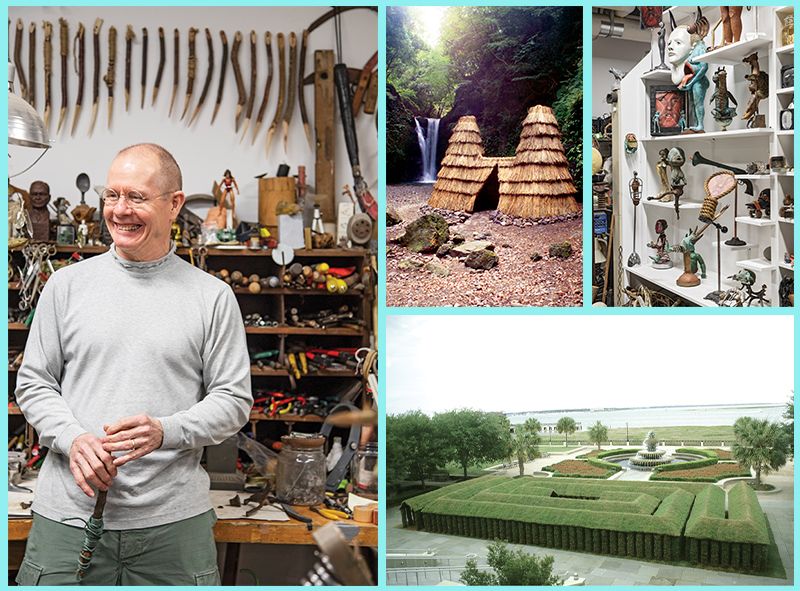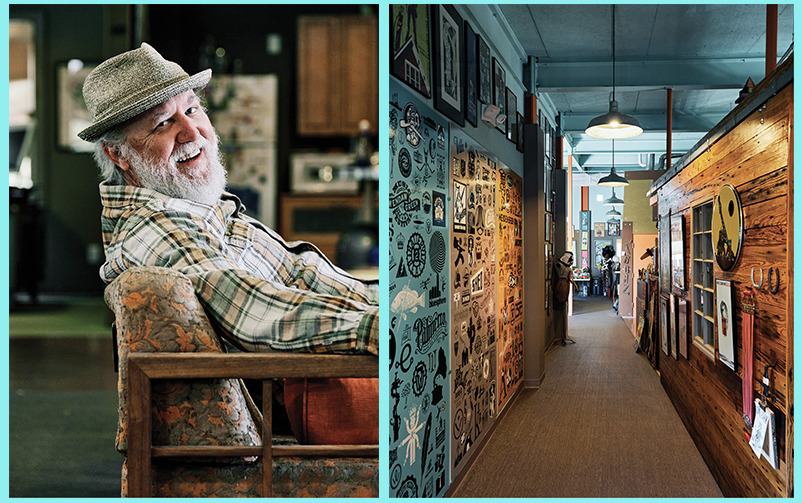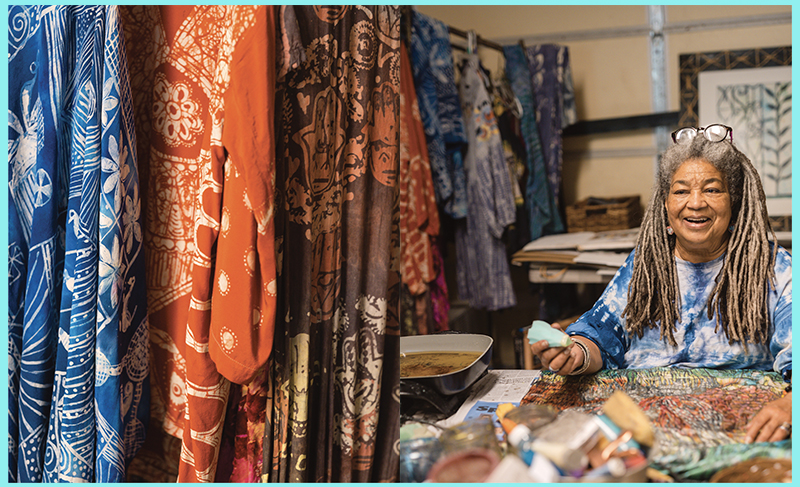Visit the creative spaces of sculptor Herb Parker, painter Rhett Thurman, graphic designer Gil Shuler, and batik and textile artist Arianne King Comer

(Clockwise from left) Sculptor Herb Parker; his nature-based works draw inspiration from the locale; Takihata Dialogue, a thatched structure Parker built in Japan in 2001, modeled after the area’s early pit dwellings; “I’m a pack rat and a dumpster diver. When I see something interesting, I’ll pull it out and bring it in the studio to see if it will trigger an idea;” Piccolo Labyrinth at Waterfront Park in 2004.
HERB PARKER, sculptor & installation artist
Southern Gothic meets dark humor in a warehouse of intriguing finds
Herb Parker’s studio is riotous proof that one man’s trash is a sculptor-and-tinkerer’s treasure. Shelves galore display an unruly collage of found objects: pieces and parts of mannequins, lamps, old dolls, metal this-and-that—all artistic prompts of a sort, ready to be plucked from the shelf and incorporated into a Parker creation. Housed on the College of Charleston campus, where Parker has been a studio art professor since 1991, the space is part holding pen, part mad-artist’s laboratory, yet despite its cluttered menagerie of mysterious and semi-eerie objects, the studio feels graced with a quiet and organized vibe.
It’s here that he works until the wee hours of the morning without music or distractions. Here is where inspiration strikes, or arises, or tumbles out of a mishmash of objects. Parker’s work falls into two distinct camps: large outdoor nature-based installations that he has created worldwide, inspired by local cultures and materials, and small-scale sculptures of found objects that come to life in this studio as abstract configurations. These smaller object-based pieces have been his focus during the pandemic, when working on larger landscape-based sculptures, of which he has some 60 around the world, was curtailed.
Walk through Herb’s Piccolo Labyrinth at Waterfront Park
“I’m a pack rat and a dumpster diver. When I see something interesting, I’ll pull it out and bring it in the studio to see if it will trigger an idea. I’ll walk around late at night and grab this, maybe cut that in half, and attach this to this,” he says, gesturing to various whatnots. “I have a big box of old parts in the back that I can cut up and rearrange.”
Against one wall, a small wooden church sits on a table with a stern-looking hawk on its roof, staring down at animal-like creatures (well-chewed dog toys) entering the church’s door. The scene is disturbing, almost macabre, with those animal creatures soon to be victims of prey. Parker, who grew up in North Carolina, served in the Marine Corps, and earned an MFA from Eastern Carolina University, isn’t afraid to tackle tough topics. He’s like that hawk, swooping down on the jugular of politics and religion in America today.
“I consider my current object-based work to be Southern Gothic. It is occasionally grotesque with elements of fatalistic romanticism and dark humor that serve as an absurdist social critique,” explains Parker, a recipient of the Southern Arts Federation Fellowship in sculpture and visual arts awards from the Southeastern Center for Contemporary Art. “This work more accurately reflects the excitement and frustrations of day-to-day existence than my more ethereal interactions in the landscape.”
In a semblance of life imitating art, Parker’s studio is a physical representation of the many ideas he wrestles with in his work. Time, movement, history, culture, community, dialogue, spirituality, entropy, and regeneration, he says, are among his motifs. And here, in his delightful studio ode to entropy and regeneration, they all abide, converse, and bump up against one another, waiting to take shape. >>See more of Herb’s studio & work

Natural light floods into Rhett Thurman’s King Street studio, located on one floor of the building in which she has lived and worked for 24 years.
Capturing vibrancy and light in an atelier on King Street
Like a second moon each night, the Charleston Place clock high above King Street shines through the windows of Rhett Thurman’s home studio. A ceramic mug filled with brushes and tubes of oil paint rest on a cricket table, layered in a paint-flecked patina after decades of use. Her easel, bequeathed to her by a former art professor and mentor at Queen’s University of Charlotte, is wreathed by an ad-hoc mood board of sorts—photos, studies, and sentimental images. “I work from my photographs, as well as sketches, plein air, and life,” she explains. “My ongoing theme is capturing the spirit of a moment.”
The spirit of Thurman’s studio reflects the artist’s grace and warmth. Brilliant, natural light streams in. Paintings, both finished and in process, abound; gold frames stacked by the stately fireplace lie ready, waiting. Known for her richly hued impressionistic paintings of landscapes, street scenes, and people in a moment in time, Thurman has lived and worked in this space, a residential oasis in the middle of the King Street shopping district, for the past 24 years. “It was once a hotel of questionable repute,” she recounts. “You can still read the word ‘Stag’ on the south side of the building, and on the top floor, I left the numbers on the rooms. I mean, lucky number seven, come on!”
The rest of the four-story home, however, she fully restored, regaling in its high ceilings and original heart pine floors and transforming the second floor’s front room from a battleship gray office with cubicles into her airy studio with ideal lighting. “There is not a dark moment in the day. In the morning, I’ve got a more direct light, mostly from the east. As the day goes on, there’s this incredible bounce of light off Charleston Place,” says Thurman, who thrives off the energy from the busy street below.
Celebrate 50 years of painting in Charleston with Rhett
The space is filled with antiques, objects from her travels around the world, and of course, art. By the door, a painting of a family huddled together in a banquette enjoying dinner at a local restaurant. Beside her easel, a newly finished painting of sunseekers lounging in a park. A portrait of a radiant Indian dancer faces her work space.
“I love painting people in context—people doing things,” says Thurman, whose work hangs in collections around the world. “And the subject matter is all over the place. I paint anything and everything around them that also involves dazzling light and color.” She keeps photo collages of family and longtime local artist friends, including Betty Anglin Smith, Eva Carter, and Margaret Petterson, just beyond her easel. “Having their faces looking at me is encouraging,” she says.
Thurman is disciplined, showing up in her studio each morning and listening to an eclectic mix from Willie Nelson to Gregorian chants to keep her company. Her husband, Harry, pokes his head in periodically during the day on his way to his study, offering feedback. “At this point in my life, I can’t imagine separating from this studio,” says Thurman. “It has become so much a part of who I am and how I work best.” >>See more of Rhett’s studio & work

(Left) The principal of Gil Shuler Graphic Design in his Mount Pleasant business office-studio he had built in 2007. Throughout the pandemic, he has been working here solo—just him with his “stuff” and his imagination. (Right) The hall of logos (large panels used as an art show installation) includes iconic branding for companies, from the Charleston RiverDogs to Palmetto Brewing to Hank’s Seafood, as well as what Shuler calls “weird collectibles,” such as the 1950s chest exerciser.
In the studio that Gil built, retro-mania meets rock-n-roll
Imagine being inside a board game called “Wacky Memorabilia,” and you’ve got a sense of what following the path to graphic designer Gil Shuler’s desk feels like. Roll the dice and advance down the hall of logos, past the 1950s Formica-topped conference/pool table and the Vendorama ballpoint pen dispensary, before you stop at the gallery of T-shirts (several hundred of them.) Roll again, turn the corner, pull his grandmother’s childhood scrapbook off the shelf, then advance to the freestanding bathrooms lit by solar tubes. Continue past the bear-headed mannequin sporting bedazzled pants, before you land in the mid-century mosh pit complete with a mod hand-shaped chair. You’re getting closer, but first, give a nod to the 1960s hair dryer and green Army guys doing yoga before you reach the desk (and collection of old golf balls). If you’re lucky, the game’s theme song will feature Shuler jamming on his electric guitar.
This studio is a work space—and a play space—for the wildly talented founder of Gil Shuler Graphic Design in Mount Pleasant, for whom work and play seem whimsically intertwined. “This space, man, is where I turn the music up really loud, and I got all this stuff around me. It’s better than a blank white void,” he says, hippie lingo a-flying. “I think that might be one of the best things about this studio—people enjoy coming here and seeing all of my stuff.”
Built 14 years ago, the second-story studio is part of a complex of five offices designed by architect Reggie Gibson for Shuler and a partner. It features a wide-open space with plenty of natural light and giant steel girders that brace a big sunny deck, overlooking trees and a small pond. Ah, yes, the pond. If Shuler’s not designing some jaw-dropping logo or iconic branding for a variety of businesses and institutions (College of Charleston, Two Blokes Brewing, The Obstinate Daughter), or not playing guitar, he’s either fishing or dreaming about fishing.
Learn about Gil’s redesign of the College of Charleston branding
And this quirky studio is where Shuler fishes for ideas and inspiration, a boundless pond it seems, given his output. A glance through his late-2020 book, Barn Jam Posters, a collection of 180-some concert posters that Shuler has produced weekly since 2008 for the Awendaw Green music venue, is evidence of both the artist’s discipline and prodigious creativity (there are more than 600 in all). Week after week, Shuler’s poster is a brilliantly fresh riff on the same themes (guitars, barns, mason jars, fish, and wildlife are his primary fodder for this series). The Sumter, South Carolina, native and Mount Pleasant resident often returns to his studio on Tuesday evenings after supper to come up with the designs for that week’s edition of the ongoing pro-bono project.
Before COVID-19, Shuler’s studio doubled as his company office and housed his colleagues at Gil Shuler Graphic Design, but for now, it’s just him surrounded by his “stuff” and a relentless imagination. “Third grade was the only year I ever got all A’s in school. I’m pretty sure it’s because I did a still life pastel of some irises for my teacher,” says Shuler, who earned a Bachelor’s of Fine Art from Western Carolina. “I didn’t know what graphic design was until my professor told me it entailed making logos and album covers.” Shuler was all in from that point on. Still is. >>See more of Gil’s studio & work

In her garage work space, batik artist Arianne King Comer uses foam rubber that she shaves into a cone to apply warm wax to fabric. It’s a technique she picked up while studying in Nigeria.
Wax and dyes transform all manner of fabrics and forms with pattern, color, and passion
You know you’ve arrived at Indigo House Studio when your eyes catch the gleaming blue glass in the bottle tree in Arianne King Comer’s front yard. An African folk art tradition brought here with the slave trade, the bottles catch light and dazzle color across the neighboring houses as the sun moves across the sky. Beside it, a mailbox hand-painted in indigo blue with a repeat pattern and bold numbers hints to the whimsical pizzazz the celebrated textile artist has brought to her North Charleston neighborhood since moving from St. Helena Island in 2005.
Comer’s “studio,” however, isn’t contained between four walls. Her batik process, a wax-resist dyeing technique, stretches all over her house and garden, from her garage, redolent of warm wax and pigment, before moving outside to dye the fabric. The multimedia artist, who holds a BFA from Howard University, honed her craft and developed her love for indigo in Nigeria, thanks to a United Nations grant to study under renowned batik artist Nike Olyani Davis in 1992. “This work is both my passion and my meditative medium,” she says.
Her primary work space in the garage is jam-packed with colorful bolts of fabric, indigo-stained gloves, jars of pigments, mannequins, racks of dresses, and boxes of wax alongside big pots of dye. She sits at a table big enough for rotating large swaths of fabric so she can work multiple areas at a time. This is also where she cuts and sews fabric for her pieces, which range from framed paintings and quilts to silk scarves, banquet napkins, and even baby onesies.
Listen as Arianne discusses the use of indigo in her work, and fellow artists’ work
Her studio is tight, but she loves filling it with the energy of students and visitors as often as she can, something she’s missed during the pandemic. “It’s been a hard year. As many of my artist friends and I remind each other, we might not be able to solve life, but we can solve art,” she says as she gingerly dips a piece of seat cushion foam into the warm wax and dots it on the fabric. “A trick I learned in Nigeria,” she explains.
In her “outside studio,” Comer dyes fabric in giant buckets to create her intricate and layered designs. Batik requires repetitive wax application and dyeing when working with multiple colors. The pieces need to dry in between applications, so Comer has placed a large, twisted metal sculpture in the garden as a pseudo drying rack, and thus the draped fabric becomes its own temporary art installation as part of her artistic process.
The work she creates here in her studio and garden, from roots in this very soil, has been shown across the country, including at the National Museum of African American History and Culture in DC, the Gibbes Museum of Art, and the Penn Center on St. Helena Island. And yes, on a homey makeshift sculpture in her own backyard. >>See more of Arrianne’s studio & work